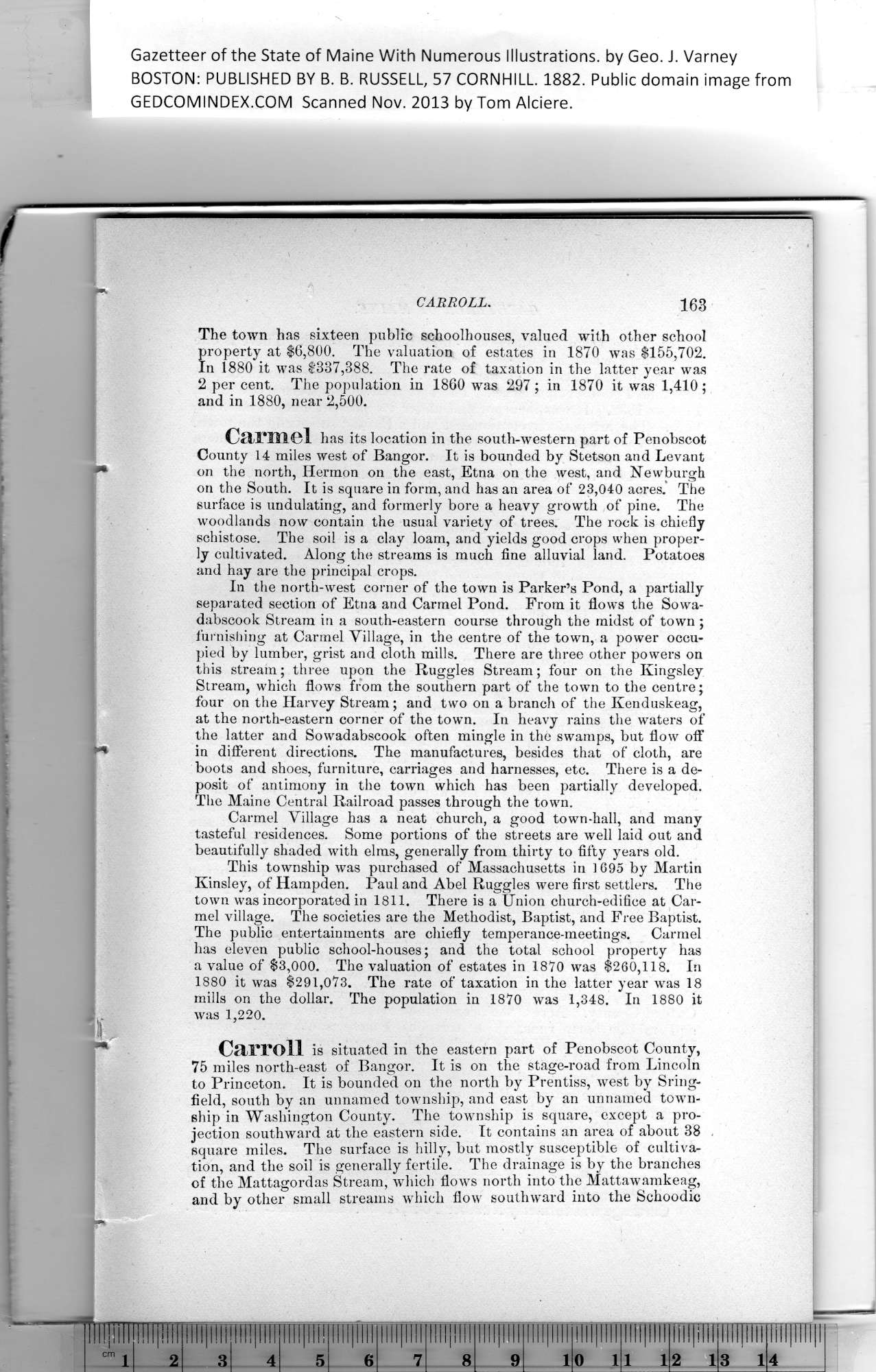|
Gazetteer of the State of Maine With Numerous Illustrations, by Geo. J. Varney
BOSTON: PUBLISHED BY B. B. RUSSELL, 57 CORNHILL. 1882. Public domain image from
CARROLL. 163
The town has sixteen public schoolhouses, valued with other school
property at $6,800. The valuation of estates in 1870 was $155,702.
In 1880 it was $337,388. The rate of taxation in the latter year was
2 per cent. The population in 1860 was 297 ; in 1870 it was 1,410 ;
and in 1880, near 2,500.
Carmel has its location in the south-western part of Penobscot
County 14 miles west of Bangor. It is bounded by Stetson and Levant
on the north, Hermon on the east, Etna on the west, and Newburgh
on the South. It is square in form, and has an area of 23,040 acres.* The
surface is undulating, and formerly bore a heavy growth of pine. The
woodlands now contain the usual variety of trees. The rock is chiefly
schistose. The soil is a clay loam, and yields good crops when proper-
ly cultivated. Along the streams is much fine alluvial land. Potatoes
and hay are the principal crops.
In the north-west corner of the town is Parker’s Pond, a partially
separated section of Etna and Carmel Pond. From it flows the Sowa-
dabscook Stream in a south-eastern course through the midst of town;
furnishing at Carmel Village, in the centre of the town, a jiower occu-
pied by lumber, grist and cloth mills. There are three other powers on
this stream; three upon the Ruggles Stream; four on the Kingsley
Stream, which flows from the southern part of the town to the centre;
four on the Harvey Stream; and two on a branch of the Kenduskeag,
at the north-eastern corner of the town. In heavy rains the waters of
the latter and Sowadabscook often mingle in the swamps, but flow off
in different directions. The manufactures, besides that of cloth, are
boots and shoes, furniture, carriages and harnesses, etc. There is a de-
posit of antimony in the town which has been partially developed.
The Maine Central Railroad passes through the town.
Carmel Village has a neat church, a good town-hall, and many
tasteful residences. Some portions of the streets are well laid out and
beautifully shaded with elms, generally from thirty to fifty years old.
This township was purchased of Massachusetts in 1695 by Martin
Kinsley, of Hampden. Paul and Abel Ruggles were first settlers. The
town was incorporated in 1811. There is a Union church-edifice at Car-
mel village. The societies are the Methodist, Baptist, and Free Baptist.
The public entertainments are chiefly temperance-meetings. Carmel
has eleven public school-houses; and the total school property has
a value of $3,000. The valuation of estates in 1870 was $260,118. In
1880 it was $291,073. The rate of taxation in the latter year was 18
mills on the dollar. The population in 1870 was 1,348. In 1880 it
was 1,220.
Carroll is situated in the eastern part of Penobscot County,
75 miles north-east of Bangor. It is on the stage-road from Lincoln
to Princeton. It is bounded on the north by Prentiss, west by Sring-
field, south by an unnamed township, and east by an unnamed town-
ship in Washington County. The township is square, except a pro-
jection southward at the eastern side. It contains an area of about 38
square miles. The surface is hilly, but mostly susceptible of cultiva-
tion, and the soil is generally fertile. The drainage is by the branches
of the Mattagordas Stream, which flows north into the Mattawamkeag,
and by other small streams which flow southward into the Schoodic
PREVIOUS PAGE ... NEXT PAGE
This page was written in HTML using a program written in Python 3.2
|
